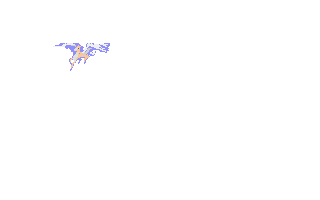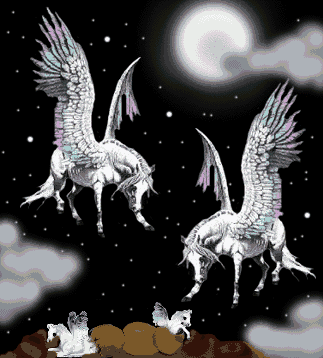
The Winged Horse

The Winged Horse
Pegasus comes to us from Greek mythology. He was born of the blood of Medusa as she was beheaded by the hero Perseus. With the help of another Greek hero, Bellerophon was able to capture Pegasus and ride him. However, when Bellerophon tried to ride Pegasus into the heavens, he was attacked by a messenger from Zeus, fell from Pegasus, and was killed. Pegasus traveled on to the heavens alone where he became a constellation, and a servant of Zeus. It is said that a kick from his hoof created the fountain of poetic inspiration.
In modern times, Pegasus is seen as the symbol for the immortality of the soul, and as the carrier and protector that guards the spirit in its journeys into the astral plane. Pegasus is the power of the creative spirit in all of us. He is the symbol of the Muses, of inspiration, and of the beauty we bring to our life and the lives of others.
If you are drawn to Pegasus, then he is calling you to create — in music — in song — in poetry — in writings — in art — in any form you choose — but CREATE and share your expressions of beauty.
Horses
are a potent symbol from almost every world religion and mythology. Many
of its myths express the horse's innate clairvoyance and ability to perceive
the magic within humans. Some view the horse as the symbol of strength,
virility and lust. According to popular belief it loses its sexual
powers when its mane is cut,
and is the only animal which shows sorrow because it weeps for its dead
master (though this is later belief is not exclusive to the Horse-Human
relationship). Also, it is a symbol for loyalty and devotion, such as the
faith it has with it's master. It also represents the warrior
spirit, bravery and courage.

![]()
Strength & Sexual Energy
TheWinged
Horse or Pegasus symbolizes heightened power of the natural forces - the
innate capacity for spiritualization and for inverting evil into good.
As a Christian and religious symbol, Pegasus was adopted from the attribution
as the mount of Apollo, the God of pure light, beauty and truth to be included
in the symbolic fauna of Christ. Winged horses, in general, symbolize the
transport of the soul of the deceased Christian to Heaven, and figuratively,
like Apollo the Sun-god, represents Christ lifted up and, like the sun,
'Full of Glory,' and as the Revealer of Mysteries and the causer of refreshing
(as in the passage: "They that wait upon the Lord shall renew their strength,
they shall mount up with wings as eagles..." - Isaiah 40:31). Also, during
the Apocalypse, Pegasus has been compared to the "white horse" whom the
conqueror rides in the book of Revelation in the Bible. Aside from
being a general symbol of creative inspiration and poetry, the flying horse
is an expression for speed, power and swift transport. As an animal totem,
Pegasus symbolizes the immortality of the soul, and serves as the carrier
and protector of the spirit in its journeys to the astral plane (especially
to the Moon - the emotional plane). Pegasusis closely linked to the Greek
gods Poseidon (Neptune) [emotion ], his father;
Athena (Minerva) [heavenly wisdom ], his protectress; Zeus (Jupiter) [guidance
& creativity ] as his Thunder-bearer; and the Muse Urania [heavenly
love ], his nursemaid, and the Muses [inspiration, memory and the arts
] in general; the heroes Perseus [intellect ] and Bellerophon [impudence
]; and the monsters Medusa [mortal wisdom ] and Chimaera [complex evil
].
Pegasus
in Film and Television. There have been very few screenplays about
or featuring Pegasus. Two of the most famous are Clash of The Titans, featuring
Harry Hamlin as Perseus with Pegasus getting the royal Ray Harryhausen
stop-motion animation treatment. The classic tale of Perseus was changed
in several areas, not the least of which had Pegasus alive and supplanting
Mercury's gift of winged sandals prior to the death of Medusa. Another
featurette produced by Lightyear and adapted from Greek Mythology by Doris
Orgel, was the animated movie simply called Pegasus
which told his entire tale in abbreviated
form by the Muse Urania. In September of 1978 a cartoon premiered called
Tarzan and The Super 7, with a superhero group called Freedom Force featuring
such mythical heroes as Isis, Merlin, Sinbad and Hercules.
In this show, Hercules' mount and constant companion was Pegasus. The animation
on the Tarzan series was the best to be presented on early Saturday morning
for quite some time. In the Spring of 1997 Walt Disney Studios released
it 35th full length fully animated feature length movie called Hercules,
where the hero's faithful steed is
also Pegasus (his trainer/companion is a satyr named Phil [Philoctetes]).
There was at least one other film from the mid 1970s which featured
young Ike Eisenmann (?) as a horse rancher's son whose new foal is born
with wings [I forget the name and details of this movie]. (See: Battlestar:
Pegasus, Pearl Rider, Sunstar, SwiftWind, USS Pegasus).
The
Pegasus Family, the family of winged horses portrayed in Beethoven's Pastoral
Symphony segment of Walt Disney's masterpiece, FANTASIA. The family consisted
of a black stallion (father), a white mare (mother) and four baby foals
colored pink, blue, yellow and black. The black colt is the only one to
eventually be named (Peter Pegasus). The Pegasus Family regularly flew
about, frolicked in the fields and gracefully floated in the rivers of
the magical place called Fantasia. There is an entire flock (herd?) of
winged horses depicted in the movie. (See: Pegasus in Film, Peter Pegasus).

Back to Mythical Magic

Created with Love
`Tai
January 1999